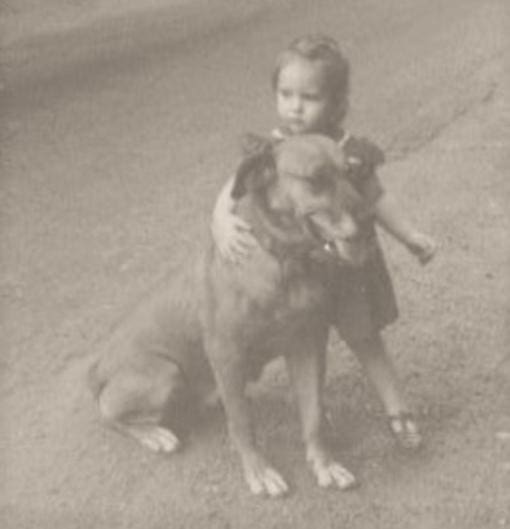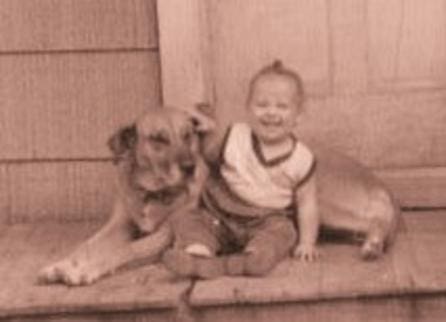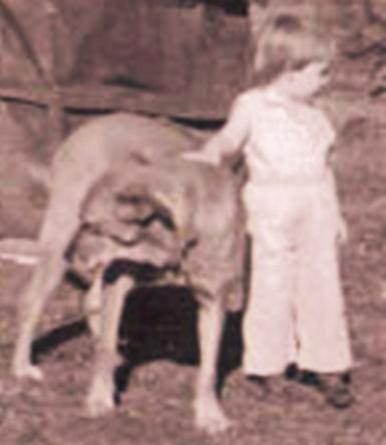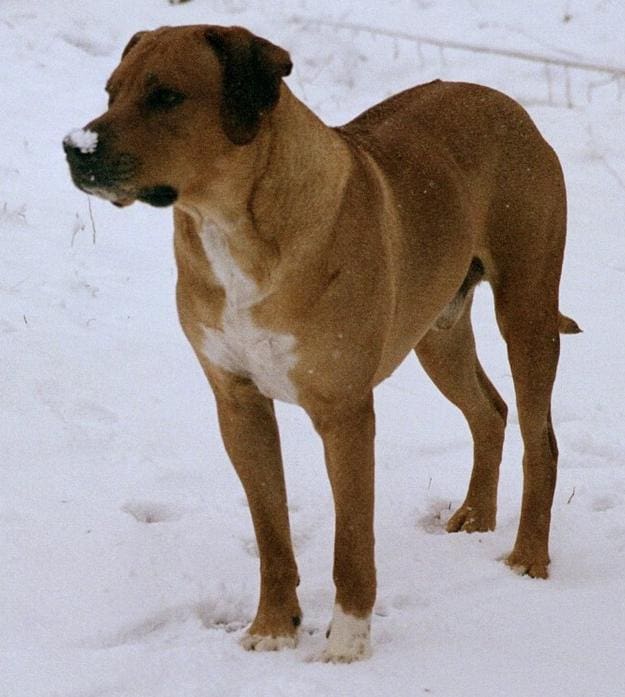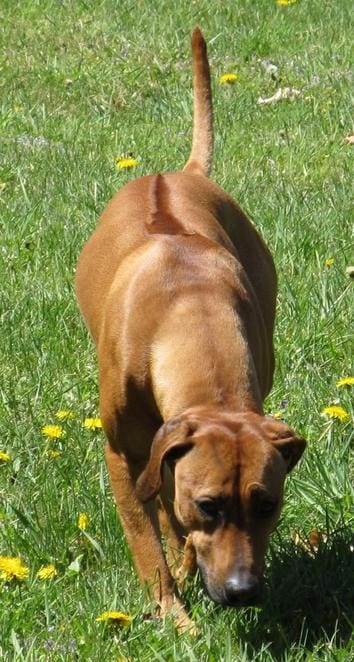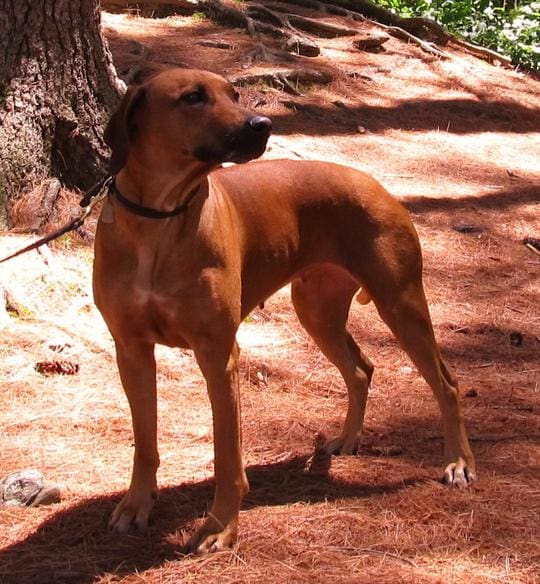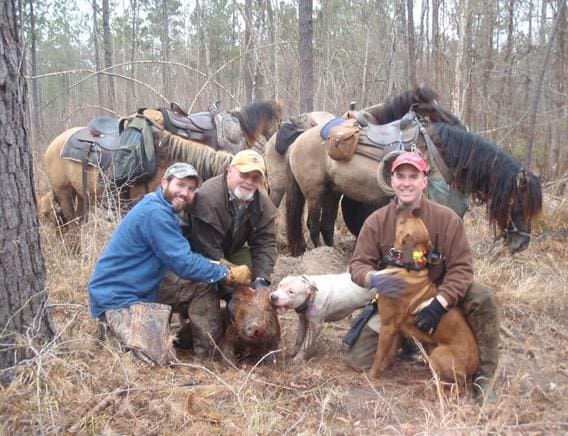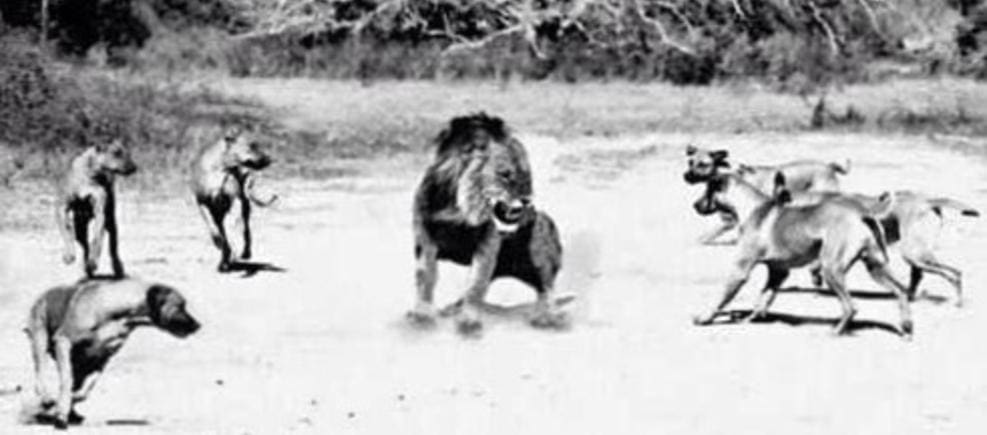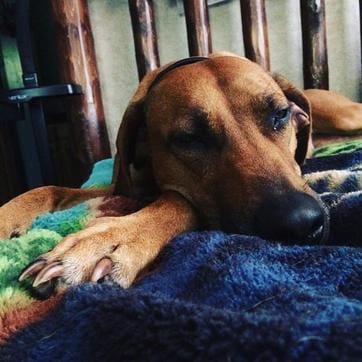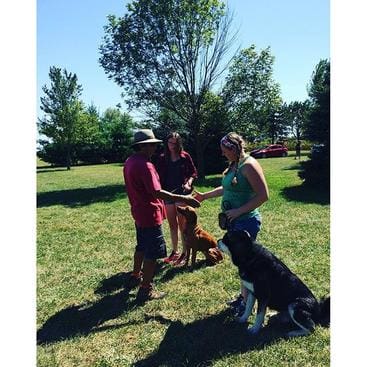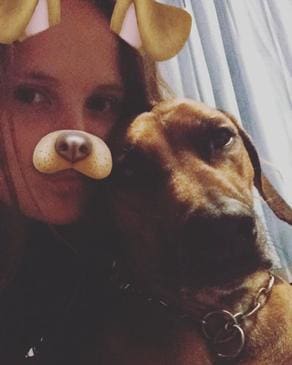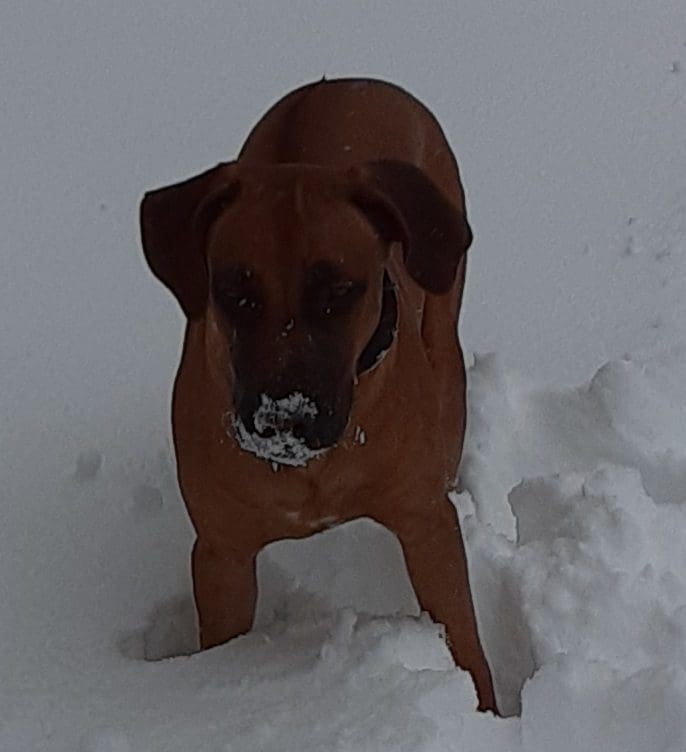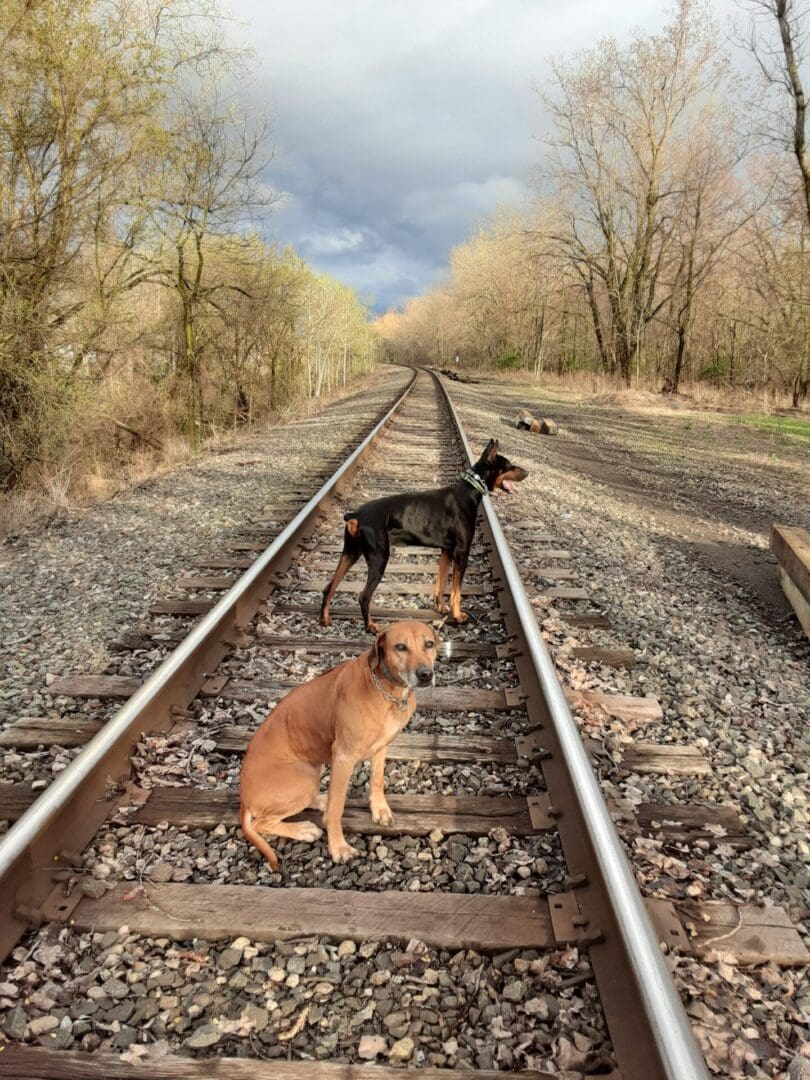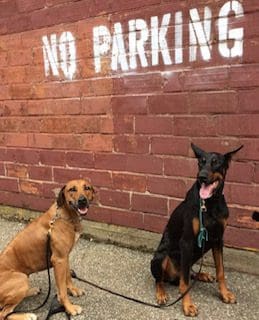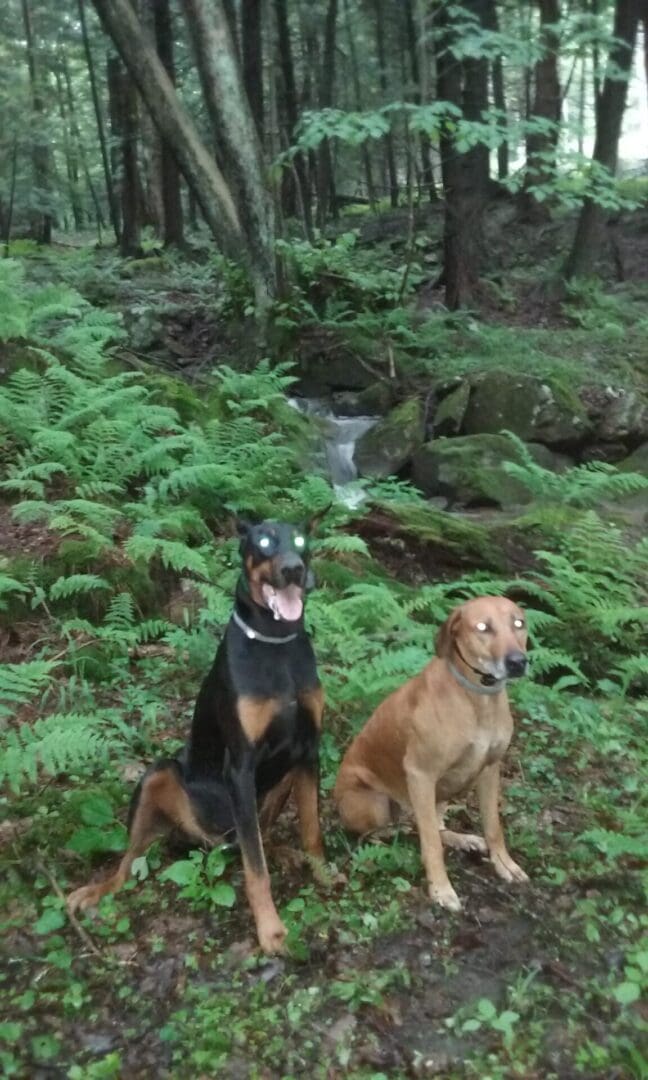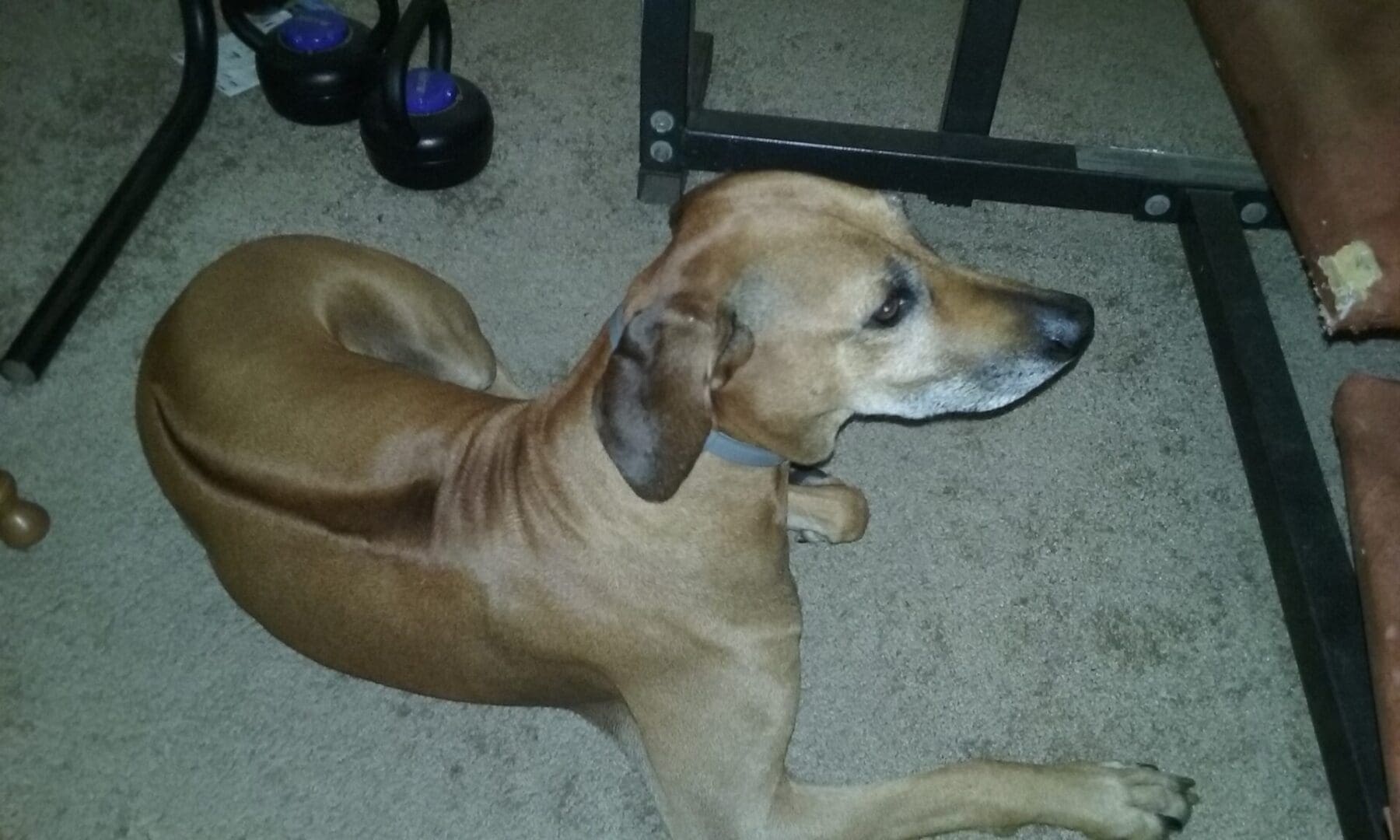Bahnhof Dobermanns: Imprinted on Rhodesian Ridgebacks!
My first contact with a Rhodesian Ridgeback was when I was 5 days old and my parents brought me home from the hospital in July of 1960. They had a 12-year-old, female Ridgeback that they obtained when she was just a puppy, imported from Rhodesia. Apparently in 1948, my mother’s sister was engaged to a man who went on safari. All summer, my aunt waited to see what treasure he would bring back from Africa for her. She dreamt of zebra skins, diamonds, and gold. To her chagrin, when my family met her fiancé in Pittsburgh, her coveted gift was in the form of, as she called it, “An ugly yellow hound dog.” That puppy ended their engagement, but it began my journey as a dog lover. My mother, an animal lover, pounced upon the opportunity to adopt the puppy with the odd ridge down her back. On the long return to Oil City Pennsylvania, my parents hung on every word the traveler told about these brave “lion hunting dogs” from Africa. At the time this dog arrived in my family's life, I was yet to be born and my brothers were ages 6 years and 8 years. They grew up with her and throughout my life, I listened to their stories of this dog's bravery.
Twelve years after that day when she was snatched up by my mother in Pittsburgh, this dog became my nanny. Her name was Pittsburgh, AKA, “Old Burger.” I don’t remember much of our fleeting four years together, but I do remember her. I have two kinds of memories of her. One kind of memory is fuzzy and continuous, like things that must have happened often and blurred into collective reminiscences that represent many of my expectations for what should be present in the world. I believe these memories are akin to what Harry Harlow examined when he studied contact comfort. He described baby rhesus monkeys preferring surrogate "mothers" who were covered in terry cloth to those made of wire. Old Burger provided a pervasive feeling of security and amiability in my world. To snuggle against her velvety coat was akin to being wrapped in a blissful cloud where all was well.
For example, I remember rubbing my cheeks on her smooth coat. I remember feeling the change in nap of her hair as my face went one direction and then the other. Additionally, I remember being enthralled with her ridge and endlessly running my fingers one way along it and then the other way along it. These memories are what I was really “imprinted on,” as far as what I expected in a dog, and maybe even in life, again, using Harry Harlow’s terminology. Old Burger was always there and the sensation of her velvety coat was comforting to me, the small child that I was way back then. When experience these kinds of memories, I don’t “see” them as much as I “feel” them. Still today, I miss her and I can become tearful when I think of her.
The other kind of memories that I have of “Old Burger” are crisper and more isolated in time. I have three of these memories that are very vivid. These memories are specific events that I picture in my mind’s eye. We lived in a very remote region in Western Pennsylvania. We had no telephone and only one vehicle that my father drove to work daily, even on Sundays. My mother and I were usually alone on our small chicken farm with this dog. I remember one time, neighbors stopping by to tell my mother to be careful because there was a pack of wild dogs roaming the area and killing sheep and calves. I remember my mom trying to intimate to me how important it was to keep an eye out for them, because if they would eat a calf, they would “Eat you too, if they get a chance.” I really couldn’t fathom what she was telling me. However, as it happened one day, while playing in the yard, three dogs came strolling up to me. To me, a three-year-old child, they were “nice doggies.” In reality, they were growling, snarling, and in stalk mode. I could feel the breath of the one dog on my face as it approached, when all of a sudden; Old Burger had it by the neck and snapped it once. It was dead. The other two dogs ran away as my mom scooped me up. There was all manner of excitement with dog wardens and game commissioners stopping by our home for a few days.
Another memory I had was one of the annual checks of the local game warden. Apparently, there was a law in Pennsylvania that all venison had to be eaten by July 2nd of every year. If a person was found in possession of venison after that date, they would be fined. It was a measure to reduce poaching. In late July and August, game wardens would often stop by homes to check the freezers for venison.
Often, when my mom was working in the garden or the chicken coop, she would have a rifle leaning against a nearby tree in case a bear or some other varmint would approach. Old Burger and I would be playing nearby. One late summer day, a Pennsylvania Game Commission truck pulled up our long driveway. My mother stepped out of the garden to meet him. The game warden appeared to be in a hurry and he came through our yard rapidly, too rapidly for Old Burger’s liking. She stepped between the game warden and us. He drew his pistol on Old Burger and told my mother, “Get your dog, or I will shoot it.” At that time, my mother picked up her rifle and said, “You shoot my dog and I’ll shoot you.” He looked at my mother, then back at the dog, then back to my mother.” He turned and left. Our freezer wasn’t checked that year.
My third distinct memory of Old Burger was waking up one cold winter morning and wanting to see her. My mom and dad had such serious looks on their faces. They were not letting me go to the door to let her inside. That’s when they picked me up, sat me on the table, and told me, Old Burger is gone. She died during the night. They explained she’d be gone forever and I could never, ever see her again. I was sad, very, very sad. I was in complete disbelief that something like this could be possible. No matter how much I cried and demanded this state of affairs be reconciled, they could not remedy the situation for me. The world was never the same for me again, because I knew dogs could die. We procured another dog, a Springer spaniel, but she was not the same. The deep, profound sadness of Old Burger’s death stayed with me for a very long time. In fact, to this day, I get choked up when I think of the day Old Burger left us.
I moved back to Pennsylvania in 1999. Upon arriving back in this area, I spent a lot of time hiking in the hills and valleys of Western Pennsylvania. One April day in 2003, I ran into a mountain lion (puma, panther, Nittany lion, whatever your favorite word is for a 150 lb, yellow cat). When I rounded a bend, it was just standing in the middle of the road. It was only about 30 yards in front of me. There is controversy as to whether these animals are native or immigrant. Either way, they are here.
Deanno wanted no part of this animal. At that time, I began to look into Rhodesian Ridgebacks because they seemed like a logical breed of dog to use to protect myself from this kind of predator. Because I had so much experience with working line Dobermans, I looked for the equivalent of a working line Ridgeback. I was not certain what kind of work Ridgebacks would do, as lion hunting is no longer allowed in Africa. Furthermore, I don’t know anything about hunting or how to contact hunters who use dogs for large game. I found some hunting magazines and websites like Full Cry. I started to talk to hunters. I found that there are people in the southern US who hunt wild "hogs" that can weigh as much as 600 lbs and some of them use Rhodesian Ridgebacks. I started to speak with people who do this sport and have these kinds of dogs.
In May of 2008, I purchased Wild Wood’s Kilimanjaro (“Yaro”), out of South Carolina hog hunting lines. I instantaneously fell in love with the texture of his coat and his ridge, his beautiful and luxurious ridge. Finally, after 44 years, I once again had a Rhodesian Ridgeback. And, of course, he was just so sweet... and then when he grew up, so AMAZINGLY protective of me. I LOVED this dog.
In May of 2008, I purchased Wild Wood’s Kilimanjaro (“Yaro”), out of South Carolina hog hunting lines. I instantaneously fell in love with the texture of his coat and his ridge, his beautiful and luxurious ridge. Finally, after 44 years, I once again had a Rhodesian Ridgeback. And, of course, he was just so sweet... and then when he grew up, so AMAZINGLY protective of me. I LOVED this dog.
Yaro was very much different than a Doberman. When walking around my field one day, he began to cry, a pitiful cry. I turned toward him. He held up his paw, as though it were hurt. He sat down and held it up more. Then he cried more. I ran toward him, thinking, “Ahh. Poor puppy.” When I arrived to look at his sore paw, he sprung into action, dodging and diving, play attacking me. I thought, “Humm? I bet that trick works well to lure the lions in close. He feigns an injury, and then when the lion gets upon him thinking he is easy prey, he springs in to action.” I have trained more than 20 Dobermans and hundreds of other dogs and I never saw another dog of any breed perform this maneuver.
A second behavior Yaro performed that I never saw in other canines was, when playing with another dog, he would run as fast as he could with the other dog in tow. Then, he would duck one of his shoulders and roll. The other dog unable to stop, would leap over him as he rolled. Then Yaro would stop via the rolling action and would be aimed 180 degrees from where he was headed when he began the roll. The other dog would continue to try to stop and Yaro would have a significant lead in the opposite direction. This is another amazing maneuver that Yaro displayed that would be very handy in fighting big predators. You can see Yaro in action on YouTube:
In August of 2010, I was walking around my field when Yaro and my Doberman, Kira ("G" Litter's dam), ran into the woods. When I called them back, a White Tailed deer fawn that was following them almost tripped over them coming back into the field. I thought, “Gee, you don’t see a fawn follow dogs very often? Humm? Wonder why it did that?” Then, the dogs ran ahead of me along the wood line, showing much interest in something in the woods, while the fawn high-tailed it (literally) across the field, disappearing into the woods on the other side of the meadow. All of a sudden, astonishingly, a 130 lbs or so cat strolled out of the woods where the dogs had been focused. It sauntered into the field, again about 30 yards ahead of me. Kira ran back to me, but Yaro ran right up to the cat’s nose and began to taunt it. He looked like Mohammed Ali doing the famous rope-a-dope, fancy footwork. The lion looked perplexed, but it decided to pirouette and disappear back into the woods.
On that same day, I had an email from Dustin Phillips, with whom I had been corresponding about the use of Ridgebacks hunting large game. His Ridgeback litter had been born and I could get that female Ridgeback from him, if I wanted her. On that day, I emailed him and told him I would like a female puppy. Eight weeks later, I picked up Lion Backer’s Kalahari from Phillips (AKA “Kali”), out of African import, Clachan Ngo, who is currently used to hunt hogs. Prior to his importation, he was used in South Africa for cheetah control. Both of Kali’s parents are used in South Carolina to hunt hogs. Now, she is five years old. Thus far, she is athletic, agile, intelligent, and very easily trained in obedience. Dustin is a great guy with great dogs that you can find at:
I plan to work with Dustin to maintain the desire to engage large game in my Ridgebacks. Dustin saw Yaro when I picked up Kali. He was impressed with Yaro’s compact build. Yaro was very muscular, yet not too large. He was only 80 pounds. He had a large impressive head with heavy musculature in his jaws. When I played tug with him, like I so often do with the police dogs I’ve trained, his grip was the firmest I have felt. It was pit-bull-like. His jaws could hold a large predator. Better yet, I have seen him pursue that large cat on that hot summer day in August 2010. I know he has the desire to catch large prey. That cannot be inserted into the dog. That must be “in there” when the dog is born. He has that quality and I have seen it. Unfortunately, the breeding between Kali and Yaro that I did the week before his torsion did not take, and now Yaro will not have progeny.
Thus far, the three Ridgebacks with whom I have lived are from strong hunting lines. They display a keen desire to protect their owners and they are healthy, athletic dogs. That being said, their smooth coats and simple grooming make them a perfect dog for people with busy lives. Time spent with them can be spent hiking and moving instead of bathing and brushing. I know that much of my love for this breed comes from Old Burger, my nanny, and the dog that “imprinted me” for life. Although I love my Dobermans, I also have a special place in my heart for Rhodesian Ridgebacks.
For more pictures and videos of Kali, please click on the button to the right. To see her adoptive brother, Zorro, please click on the button directly below Kali's.
